Upma is a popular South Indian breakfast made with cream of wheat or semolina flour (called rava or suji locally), veggies, spices and herbs. The upma recipe I share here is adapted from my mom’s recipe and continues to be a favorite in my home. The ingredients used to flavor the rava upma (also called suji ka upma) give it a deliciously satisfying taste that will make this dish one of your new preferred go-to breakfasts.
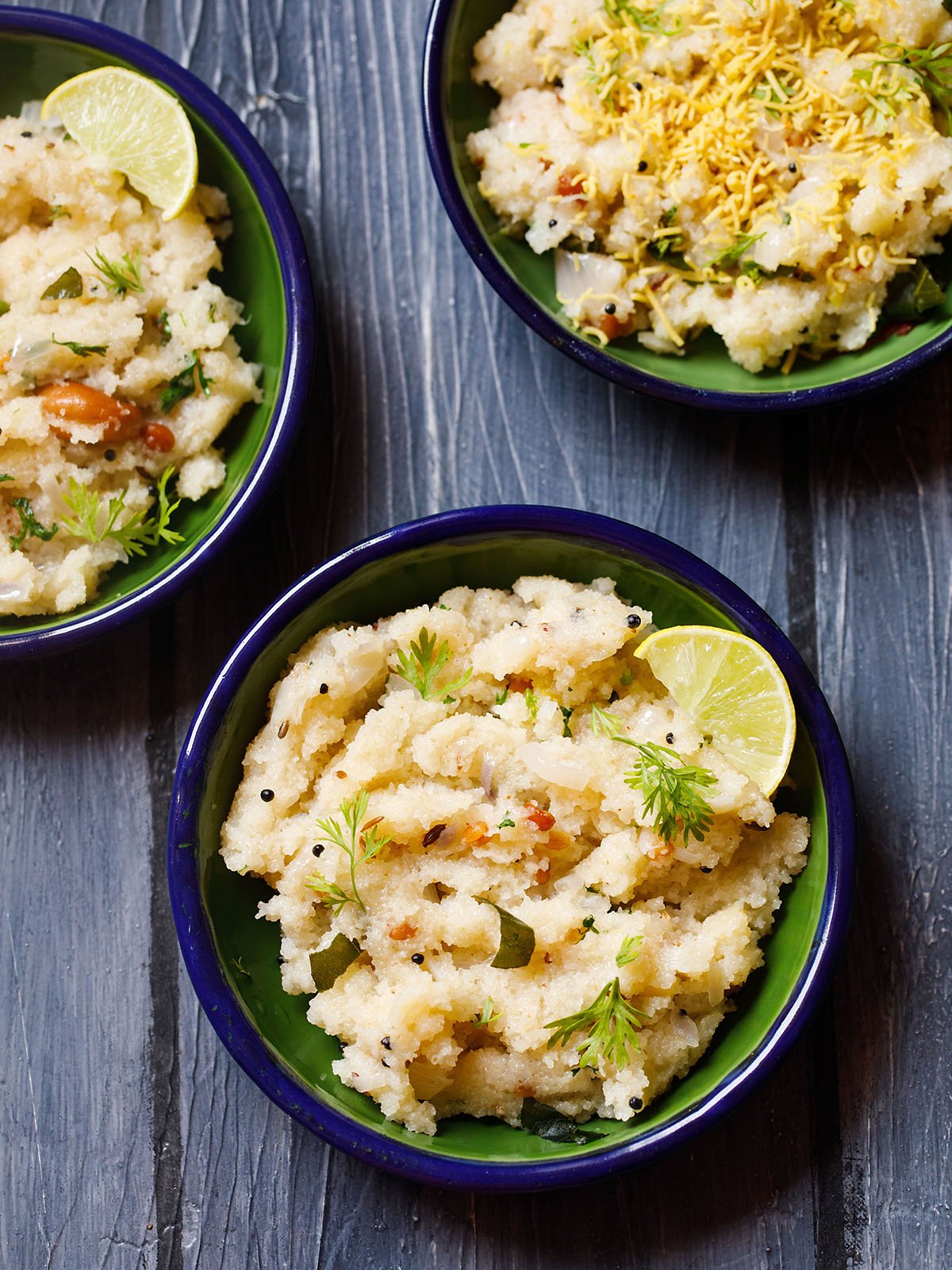
About Upma Recipe
Upma is a flavorful, tasty, savory and popular South Indian breakfast that is made with cream of wheat or semolina flour (called rava or suji), a few lentils, nuts, vegetables, herbs and spices.
This traditional dish involves cooking roasted rava in water that has been flavored by ghee (or oil), cashews, urad dal (white lentils), chana dal (husked and split bengal gram), onion, ginger and additional herbs and spices. Sugar can be added for a mildly sweet and savory dish.
Table of Contents
This steaming hot breakfast dish can be made vegan by using oil instead of ghee. Full of warmth, flavor and deliciousness, this upma tastes so good. So why not take a break from that boring oatmeal and try something new? You can’t lose!
The main ingredient in any upma recipe is rava. Also called ‘suji’ or ‘sooji‘ in Hindi and ‘cream of wheat’ or ‘semolina’ in English, it is simply granulated wheat. Thus this breakfast food is known as Suji ka Upma in North India.
What really makes an upma recipe special are all the fried and sautéed ingredients that are used for tempering. These ingredients can vary depending on the recipe, but usually include some sweet, savory and nutty flavors.
Upma is a traditional breakfast served in restaurants throughout South India, including Maharashtra. It is also a common breakfast prepared in South Indian homes. In fact, upma was a regular breakfast or evening snack in my house while growing up.
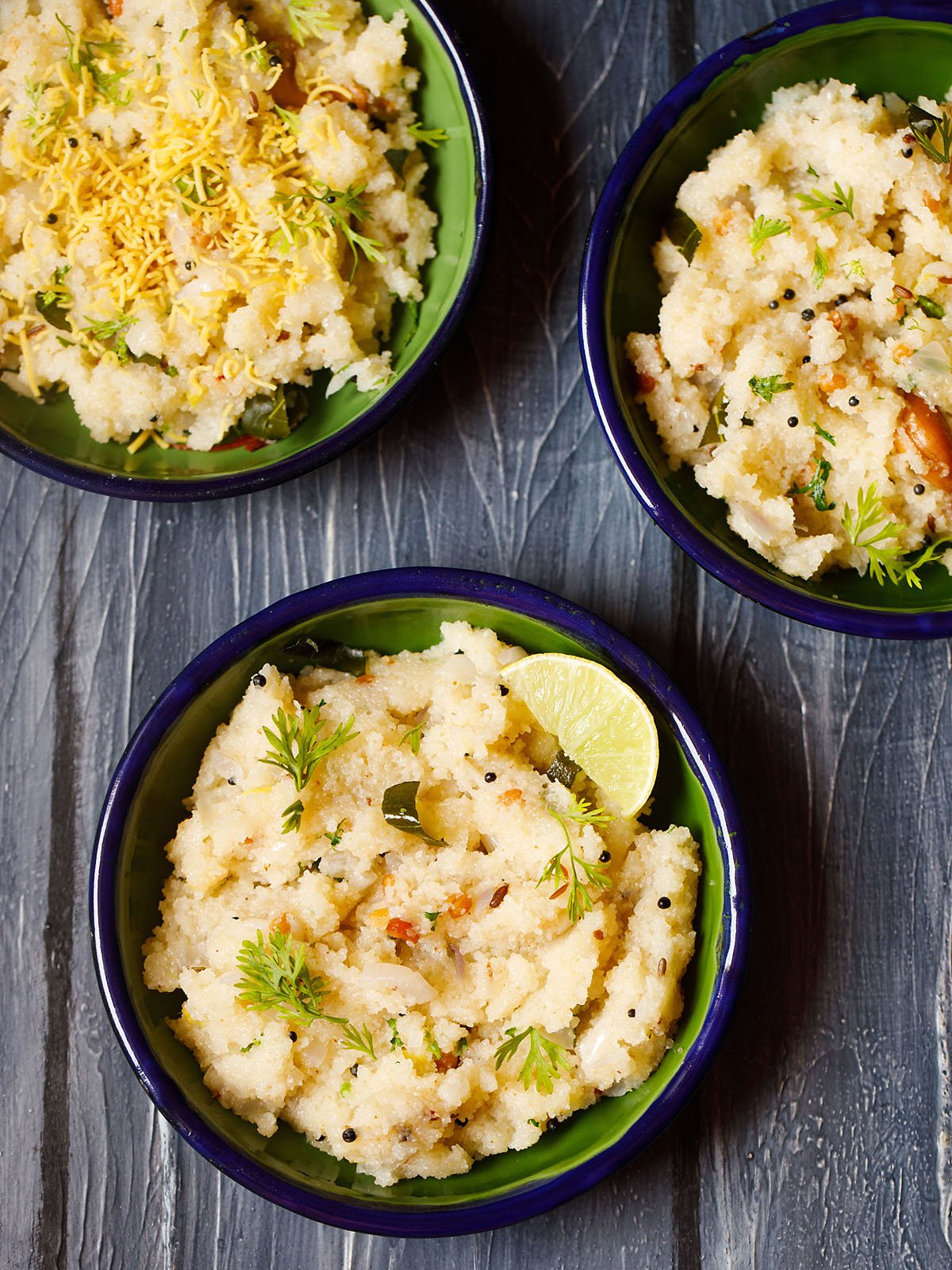
What is Rava
Rava is coarsely ground wheat to a fine or semi-fine texture. It is not floury but has a fine grainy texture. Rava is also called cream of wheat or farina or semolina flour in English.
To make upma, use the finer textured rava. You can also use the rava variety sold as Bombay rava in the Indian market.
Pro Tip to Make Upma Quicker
This warm, homemade breakfast can be made relatively quickly, especially with this one easy tip. In the step-by-step photo guide below, you will see the first few steps of roasting the rava (cream of wheat).
This can easily be done ahead of time and I actually recommend roasting your rava and keeping it in an air-tight container right after purchase. This will help it stay good longer and prevent it from becoming moldy or spoiled.
Having your rava already roasted means this hot breakfast of upma recipe can be prepared in only 15 to 20 minutes. Roasted rava can also be used in a variety of other recipes, including Rava Cheela and Rava Pongal.
How to make Upma Recipe
Prep and Roast Rava
1. Prep the ingredients first to make upma recipe. Take 1 cup rava (fine variety) and set it aside. Next gather the aromatics, lentils, nuts, spices and herbs ready. You will need:
- ⅓ cup finely chopped onions
- 1 teaspoon chopped green chillies
- 1 teaspoon finely chopped ginger
- 2 tablespoons coriander leaves (cilantro)
- 8 to 10 curry leaves
- 10 to 12 cashews
- 1 teaspoon chana dal (hulled and split bengal gram)
- 1 teaspoon urad dal (hulled and split black gram)
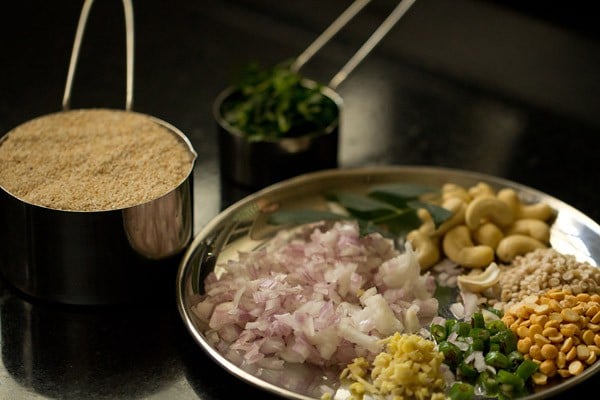
2. Heat a pan or kadai first. Add 1 cup rava or cream of wheat (fine variety).
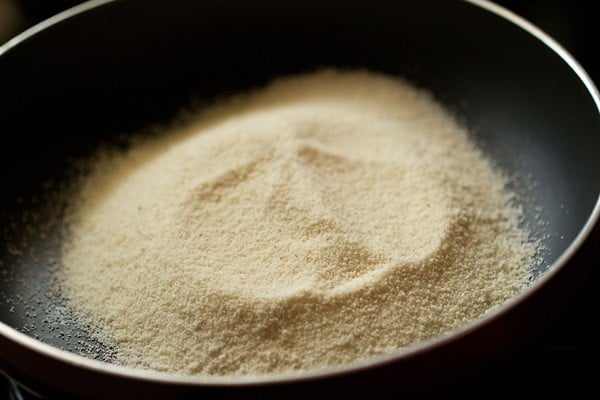
3. Begin to roast the rava. Stir often while roasting the rava.
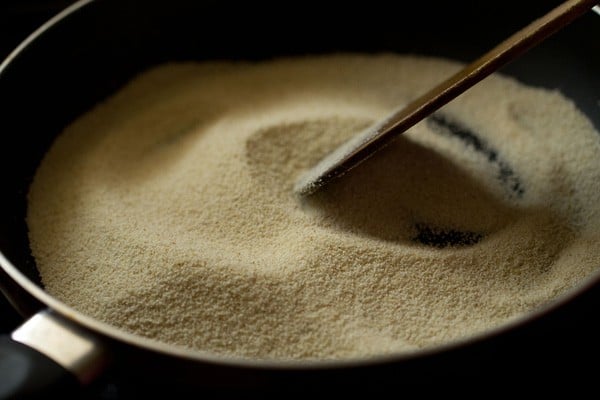
4. The rava or sooji grains should become fragrant and start to look dry, separate and crisp. Don’t brown the rava.
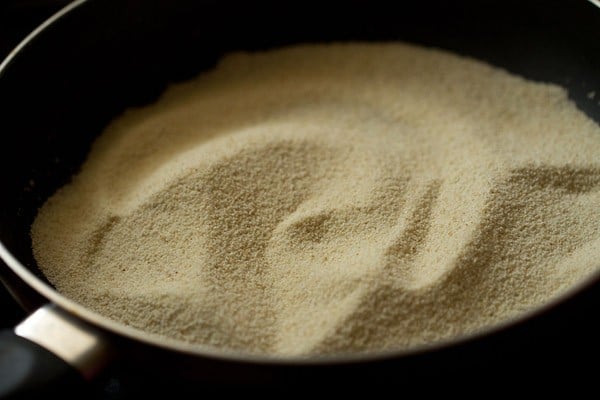
5. Once the rava becomes fragrant and starts to look dry and crisp, switch off the flame and put the roasted rava on a plate and set aside.
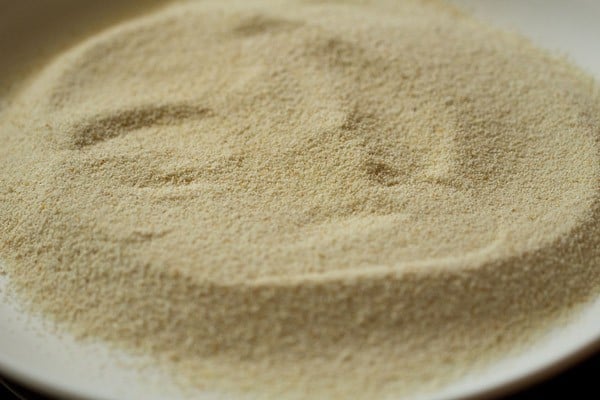
Fry and Sauté Spices, Nuts & Aromatics
6. In a pan, heat 2 tablespoons ghee (clarified butter) or oil. You could use sunflower oil or peanut oil or safflower oil or any neutral tasting oil.
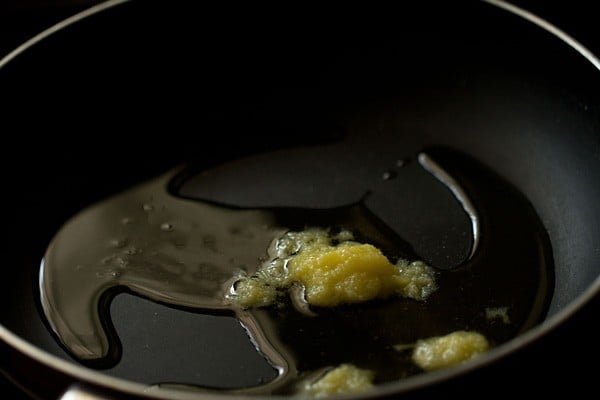
7. Lower the heat. Add 1 teaspoon mustard seeds. When you hear the crackling sound of mustard seeds, it means they are getting fried.
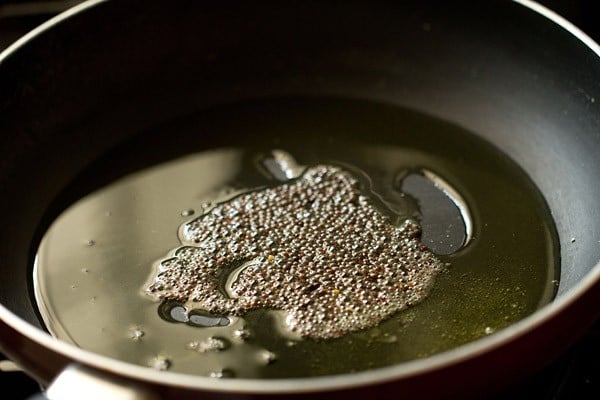
8. Now add the following ingredients:
- ½ teaspoon cumin seeds
- 1 teaspoon chana dal (husked and split bengal gram)
- 1 teaspoon urad dal (husked and split black gram)
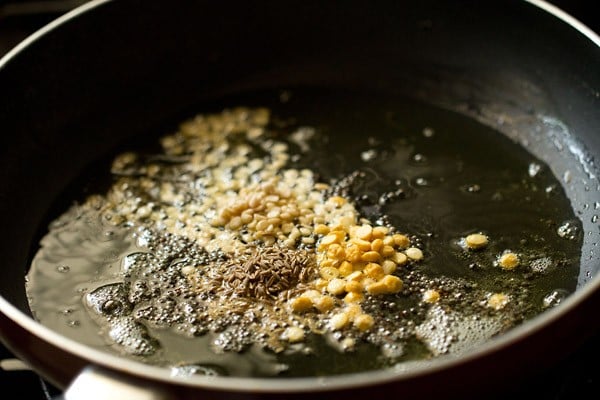
9. Stirring often fry until the chana dal and urad dal begin to brown a bit.
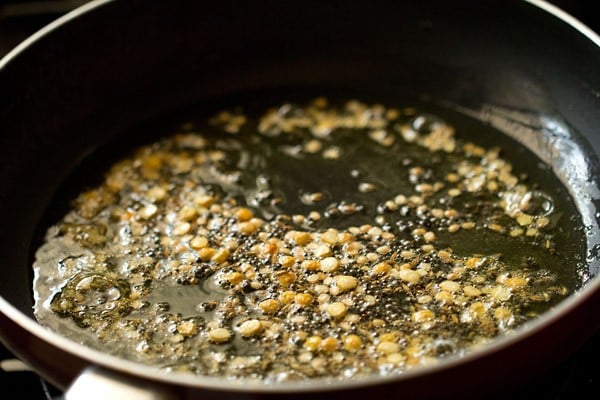
10. Immediately add 10 to 12 cashews and begin to fry on a low to medium-low heat.
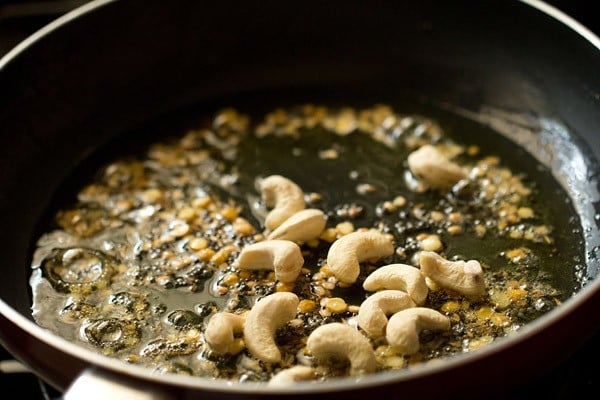
11. By the time the cashews get golden the dals should also be golden.
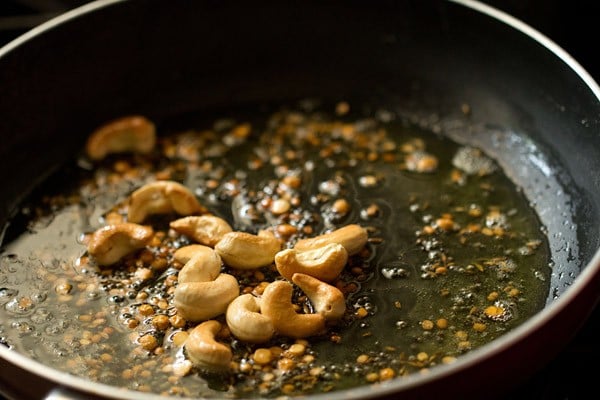
12. Now add the ⅓ cup of finely chopped onions.
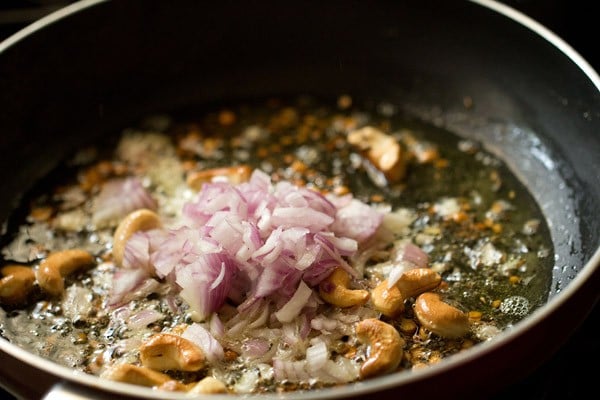
13. Sauté the onions until they soften and become translucent on a low to medium-low heat.
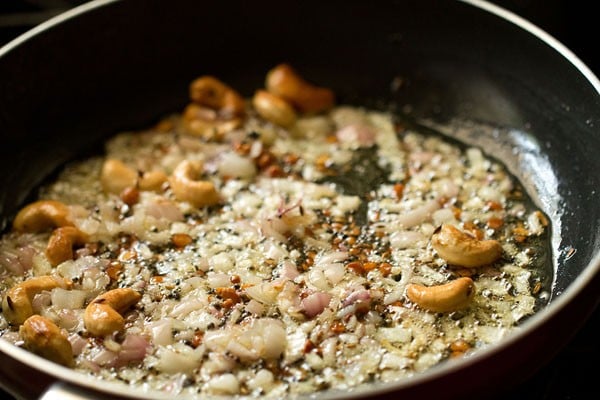
14. Then add 1 teaspoon chopped green chillies, 1 teaspoon chopped ginger and 8 to 10 curry leaves.
You can also add 1 dried red chilli (halved and with seeds removed) at this step.
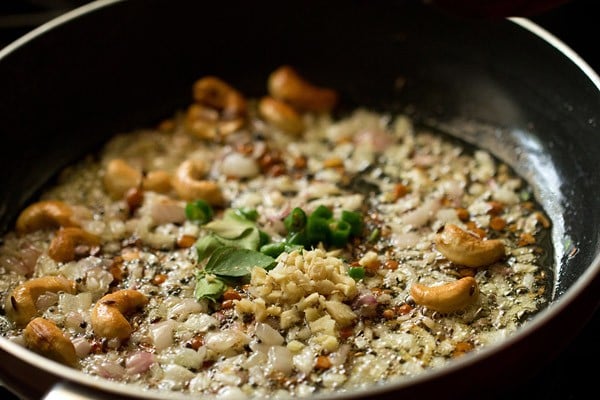
15. Mix well and sauté for a few seconds.
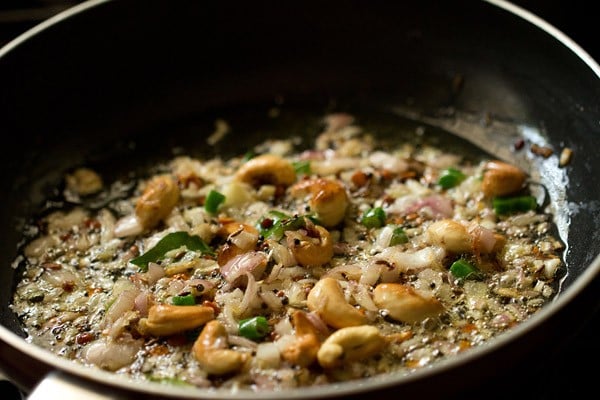
Boil Water
16. Then add 2.5 cups water to this mixture.
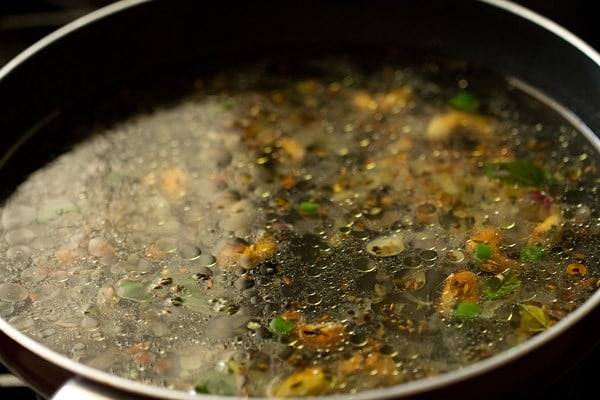
17. Add salt as required. Mix well and check the taste of water. It should be a bit salty but not too much.
In case if the salt becomes less in the dish, you can always sprinkle some salt from the top when eating.
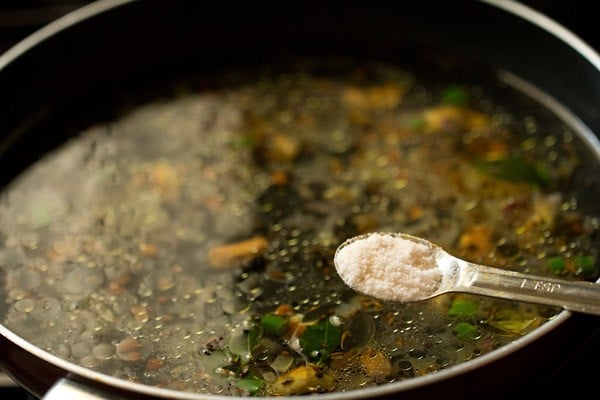
18. Then add ½ to 1 teaspoon sugar.
Sugar is optional and you can skip it. We prefer a slight sweet taste in the upma and hence we add it.
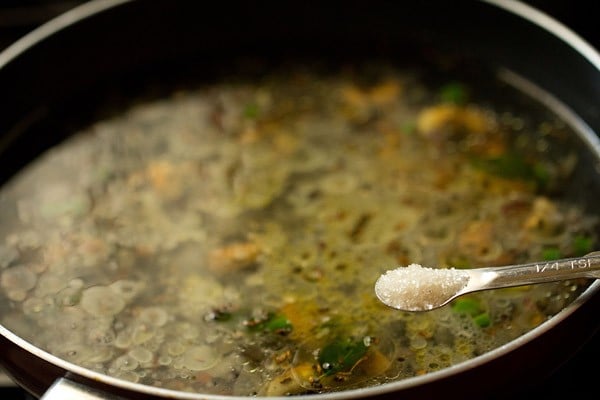
19. Stir again. On a medium to high flame, heat the water and let it come to a rolling boiling.
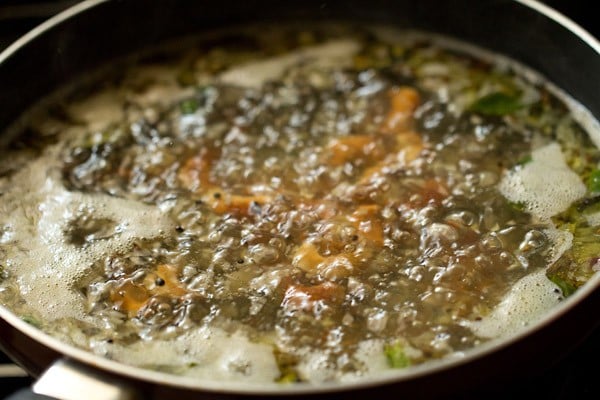
Make Rava Upma
20. When the water comes to a rolling boil, lower the flame to its lowest. Then add the rava in 4 to 5 batches with a spoon.
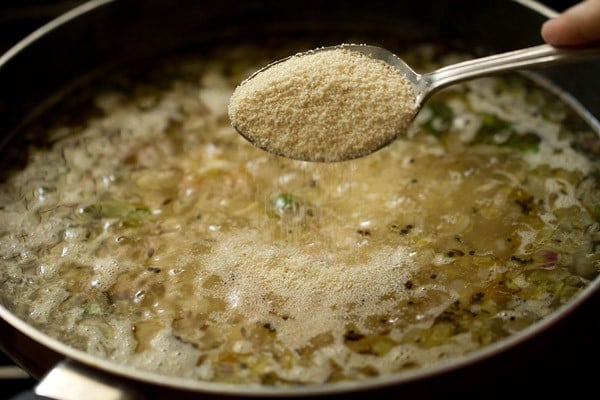
21. Once you add the first batch of rava, stir and mix immediately so that the roasted rava gets mixed evenly with the water.
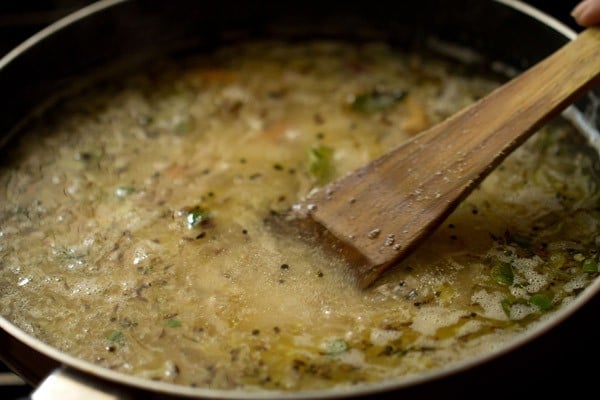
22. Then add the next batch of rava. Mix and stir again very well ensuring that the batch of rava is mixed evenly in water.
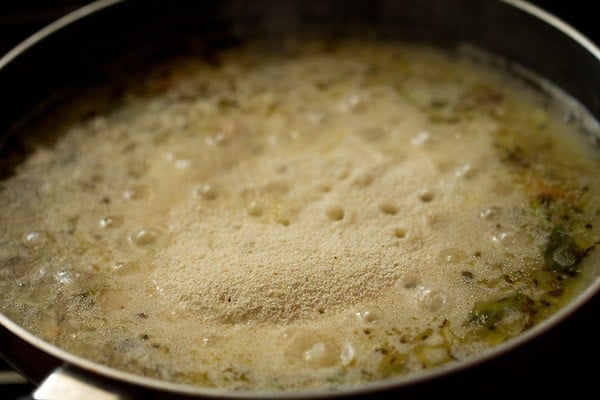
23. Continue to add and stir the rava up to the last batch.
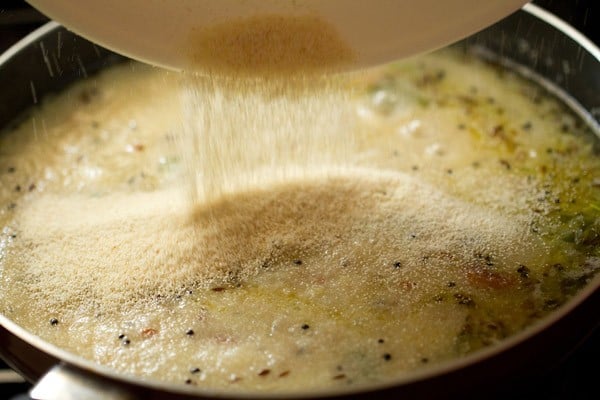
24. Quickly stir and mix very well. The rava grains will absorb water, swell and get cooked.
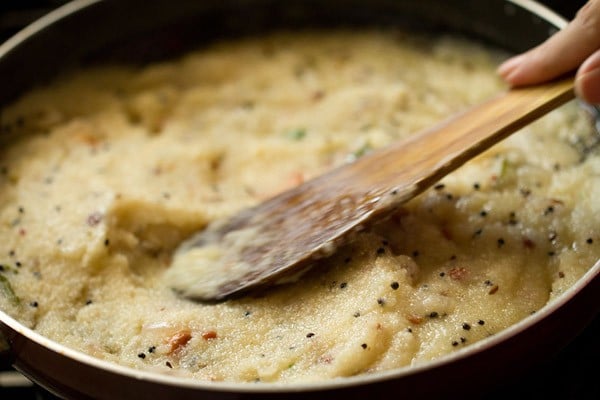
25. Cover and allow the rava upma to steam for 2 to 3 minutes on a low heat.
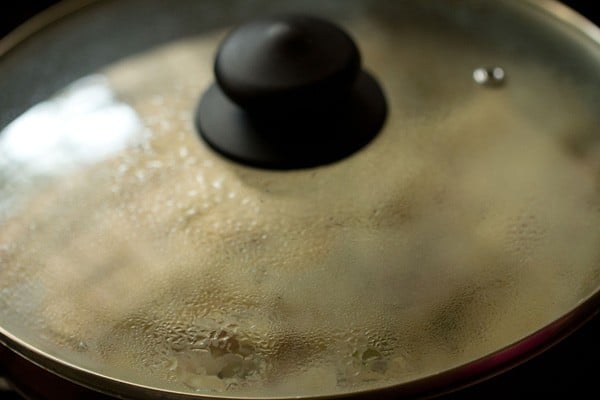
26. Then turn off the heat. In the below photo, the rava is cooked well and the suji ka upma is ready.
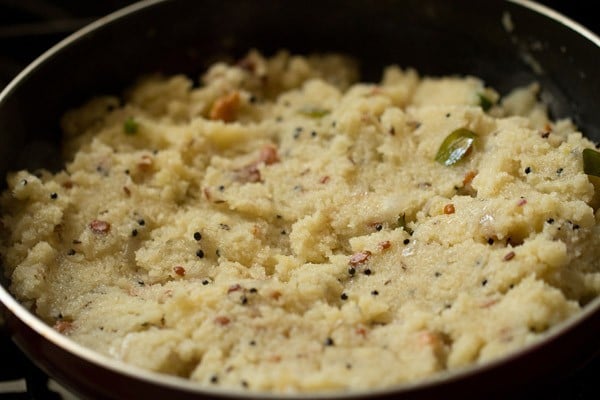
27. Lastly add about 2 tablespoons of chopped coriander leaves (cilantro). You can add more coriander leaves if you like.
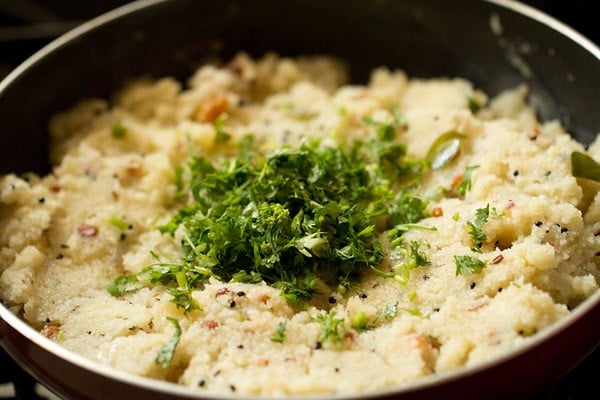
28. Mix again.
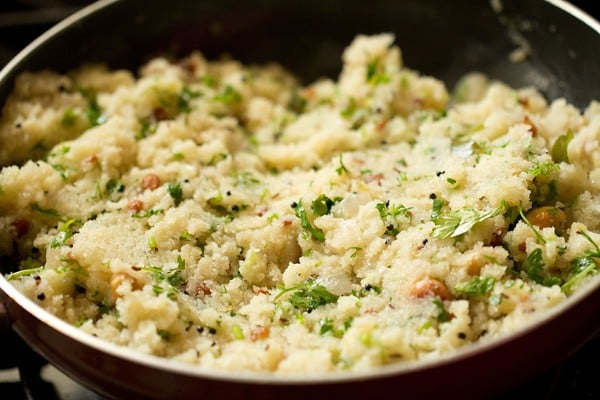
30. Serve upma hot or warm with slices of lemon or a side of lemon pickle or coconut chutney.
You can opt to drizzle half to one teaspoon of ghee while serving. If you like you can garnish with some coriander leaves.
I also sprinkle some sev (fried gram flour vermicelli) on upma while serving. Though this is not the way upma is traditionally served, the folks at home prefer this Mumbai style. You can also serve it with idli podi.
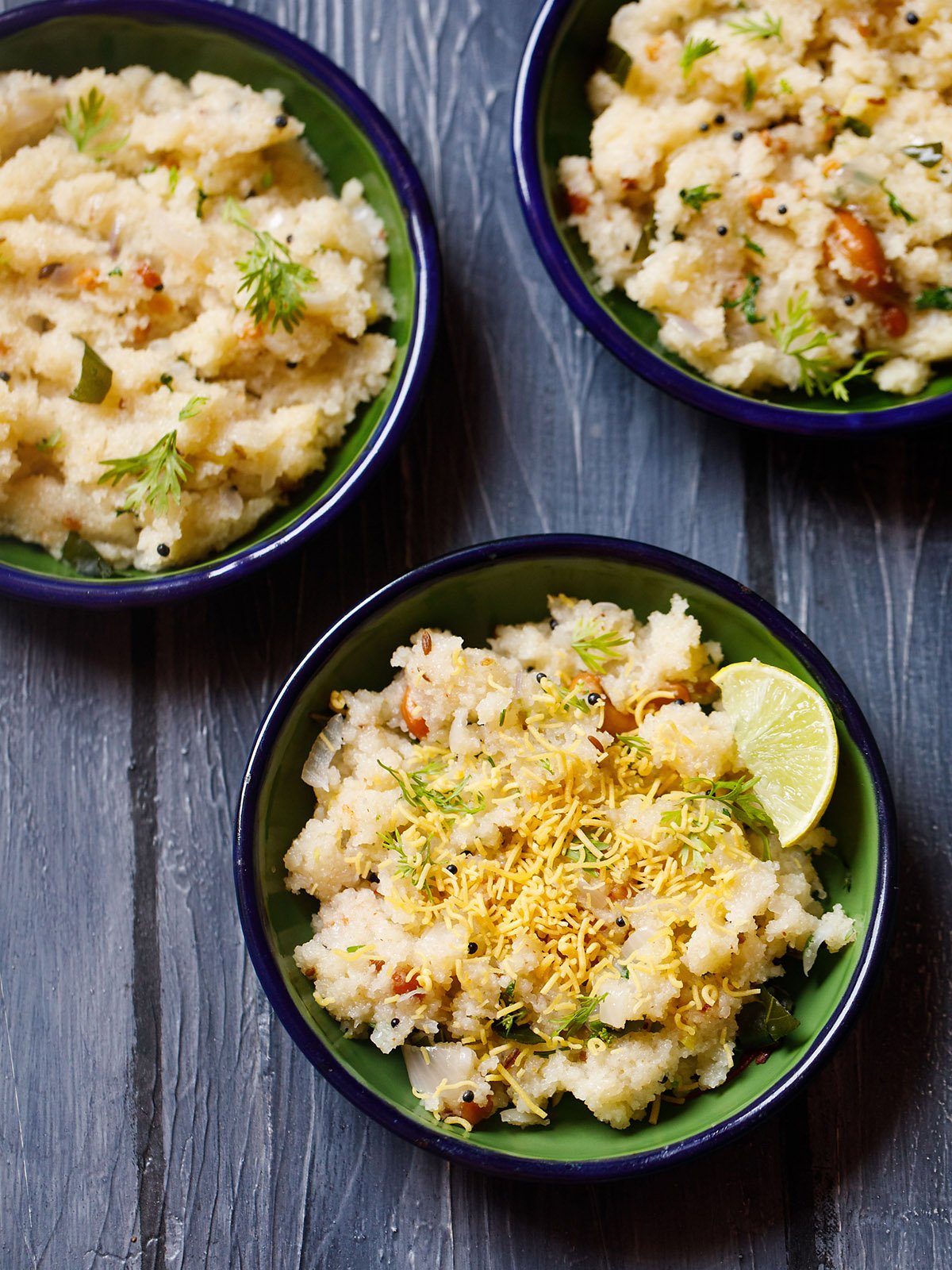
Expert Tips
- Roasting rava: For an even roasting or toasting of rava, you need to stir rava often on a low or medium-low heat of the pan. See for signs of color change and the rava granules looking separate, crisp with a nice toasted aroma.
- Adding rava in batches: Always add rava to the hot water in batches. After adding each batch mix the rava evenly with the water. This ensures that your upma will turn smooth and soft.
- Fats: Upma recipe can be made with both ghee (clarified butter) or oil. With ghee the suji ka upma tastes better though. You can even drizzle a bit of ghee when serving upma. I also on occasions make upma with coconut oil. You can use oils like sunflower oil or safflower oil or peanut oil or any neutral tasting oil.
- Rava and water proportion: For a softer rava upma, you can use the proportion of 1:2.5 or 3 for rava and water respectively. Which means that for 1 cup of fine rava you can add 2.5 to 3 cups water.
- Variations: There are a few variations, you can make like tomato upma recipe or vegetable upma or even ragi rava upma. I have listed them in the FAQs section below.
- Serving suggestions: Upma is best served piping hot or warm. Like me, you can top it up with some sev or bhujia with a drizzle of lemon juice. You can even serve suji ka upma with coconut chutney or lemon pickle or idli podi.
- Scaling and storing: You can easily halve or double this recipe. Leftover rava upma can be refrigerated for a couple of days. You can even freeze it. While reheating, sprinkle some water and reheat the upma in a pan.
FAQs
Use Kesari rava or Bombay rava as they are a fine variety of rava. Idli rava is used for making idli.
Yes, you can. Check the method I have listed in the below question.
Either steam the vegetables separately and then add once the rava is mixed with the water.
Or after sautéing onions, add the veggies (grated carrots, green peas, grated potatoes, finely chopped french beans, chopped capsicum) and sauté until lightly golden. Add water and follow the recipe. You can garnish upma with grated coconut.
Upma becomes lumpy when the rava is not mixed very well with the water. So add rava in batches and mix each batch of rava evenly in the water.
Remember to use fine rava for this recipe. If you use a coarser rava, you will have to add more water so that the upma does not become lumpy.
Rava has to be roasted very well. If the rava is not roasted properly the upma will become sticky.
More Questions Answered
Can I skip green chillies?
Yes, you can. Some crushed black pepper can be added in place of green chillies.
Can I add peanuts?
Yes, you can add peanuts. Fry or roast the peanuts separately and then add as a topping or garnish on the upma while serving.
Can I add tomatoes?
You can add tomatoes. Add them when the onions soften. Then sauté until the tomatoes soften.
How to make ragi rava upma?
Roast both the rava and ragi flour separately. Follow this recipe. When the water comes to a rolling boil, add the rava and ragi.
Depending on the amount of ragi and rava added you will need to increase the water quantity. Do roast ragi really well as undercooked ragi can cause stomach aches.
What is urad dal and chana dal and what are their english names?
Chana dal is called Bengal gram in English. These are black chickpea lentils. Urad dal are called as black lentils or white lentils.
They are shaped like mung beans except that the husk is black in color and the lentils are in white color. The other name for it is vigna mungo or black matpe beans.
More Tasty Upma Variants To Try!
Breakfast Recipes
Bread Snacks
Breakfast Recipes
South Indian Food Recipes
Please be sure to rate the recipe in the recipe card or leave a comment below if you have made it. For more vegetarian inspirations, Sign Up for my emails or follow me on Instagram, Youtube, Facebook, Pinterest or Twitter.
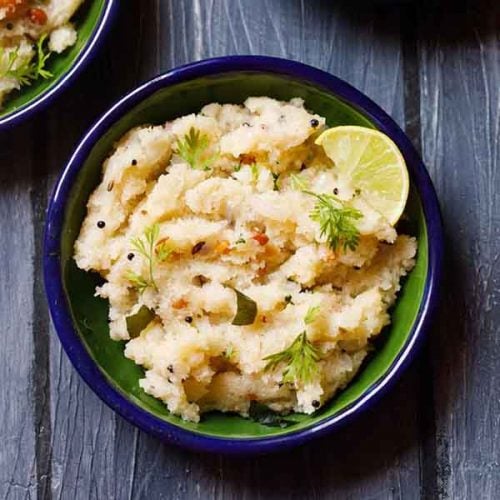
Upma Recipe (South Indian Rava Upma)
Ingredients
For roasting rava
- 1 cup rava – finer variety (sooji or cream of wheat or semolina)
Other ingredients
- 2 tablespoons Ghee (clarified butter) or oil
- 1 teaspoon mustard seeds
- ½ teaspoon cumin seeds
- 1 teaspoon chana dal (split and husked bengal gram)
- 1 teaspoon urad dal (split and husked black gram)
- 10 to 12 cashews – optional
- ⅓ cup onions – finely chopped or 1 medium-sized onion
- 1 teaspoon green chilli – chopped or 1 green chilli
- 1 teaspoon ginger – finely chopped or 1 inch ginger
- 1 sprig curry leaves or 10 to 12 curry leaves
- 2.5 cups water
- salt as required
- ½ to 1 teaspoon sugar or add as required, optional
- 2 tablespoons coriander leaves – chopped (cilantro)
Instructions
Preparation
- Finely chop 1 medium sized onion, 1 to 2 green chillies and 1 inch ginger and some coriander leaves.
- Also set aside the remaining ingredients.
Roasting rava
- Heat a pan or kadai first. Add rava or cream of wheat.
- Begin to roast the rava. Stir often while roasting the rava.
- The rava or sooji grains should become fragrant and start to look dry, separate and crisp. Don’t brown the rava.
- Switch off the flame and then add the roasted rava in a plate and keep aside.
Frying and sautéing
- In a pan, heat ghee or oil. add the mustard seeds.
- When you hear the crackling sound of mustard seeds, it means they are getting fried.
- Now add the cumin seeds along with chana dal and urad dal.
- Fry till they begin to brown a bit or get lightly golden
- Immediately add cashews and begin to fry. By the time, the cashews get golden the lentils will also get golden.
- Now add the finely chopped onions. Saute the onions till they become translucent.
- Then add the chopped green chilly, ginger, curry leaves. Sauté for a few seconds. You can also add 1 dried red chilli at this step.
Boiling water
- Then add 2.5 cups water, sugar and salt as required. Mix well and check the taste of water. It should be a bit salty but not too much.
- Sugar is optional and you can skip it.
- On a medium to high flame, heat the water and let it come to a rolling boiling.
Making upma
- When the water comes to a rolling boil, lower the flame to its lowest. Then add the rava in 4 to 5 batches with a spoon.
- Once you add the rava, mix and stir immediately. The entire batch of rava should get mixed with the water evenly. Then add the next batch of roasted rava. Mix and stir again.
- This way keep on adding and stirring the rava up to the last batch.
- Quickly stir and mix well. The rava grains absorb water and thus swell and get cooked.
- Cover and allow the rava upma to steam for 2 to 3 minutes on a low heat.
- Then switch off the flame. Here the rava is cooked and the upma is ready.
- Lastly add chopped coriander leaves. Mix again.
- Serve upma with coconut chutney or lime slices or lime pickle.
Video
Notes
- Roasting rava: The rava has to be roasted evenly. For this you need to stir rava often on a low or medium-low heat of the pan. See for the signs of the color change and the rava granules looking separate, crisp with a nice toasted aroma.
- Adding rava in batches: Always add rava to the hot water in batches. After adding each batch mix the rava evenly with the water. This will make sure that your upma will turn smooth and soft.
- Avoiding lumpy and sticky upma: To avoid lumps add rava in batches and mix each batch of rava very well with the water. Remember to use fine rava for this recipe. If you use a coarser rava, you will have to add more water so that it does not become lumpy. If the rava is not roasted properly the upma will become sticky.
- Oil or ghee: You can easily make upma with either oil or ghee. With ghee the upma tastes better though. You can even drizzle a bit of ghee when serving upma.
- Rava and water proportion: For a softer rava upma, you can use the proportion of 1:2.5 or 3 for rava and water respectively. Which means that for 1 cup of fine rava you can add 2.5 to 3 cups water.
- Serving suggestions: Upma is best served hot or warm. You can top it up with some sev or bhujia with a drizzle of lemon juice. You can even serve upma with coconut chutney or lemon pickle or idli podi.
- Scaling and storing: You can easily halve or double this recipe. Leftover upma can be refrigerated for a couple of days. You can even freeze it. While reheating, sprinkle some water and reheat the upma in a pan or microwave.
Nutrition Info (Approximate Values)
This Upma recipe from the archives was first published on August 2009. It has been updated on November 2024.
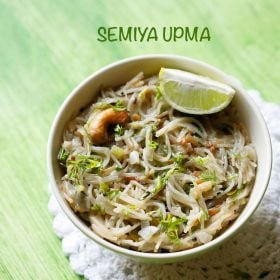
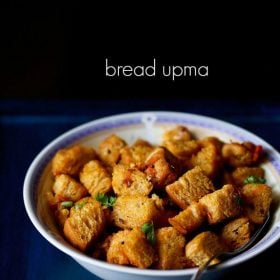
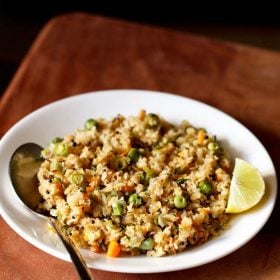
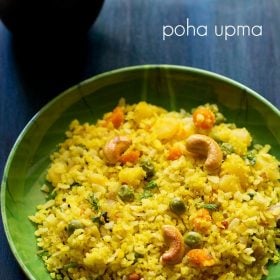



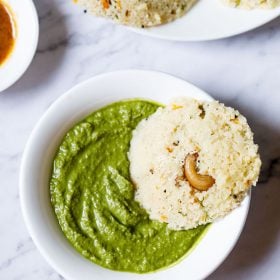








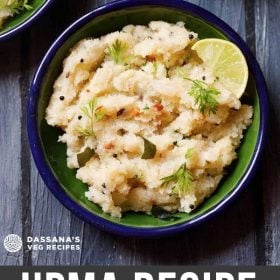
Very good recipe… perfect.
Wonderful recipe. Upma always turns out to be perfect!
Very well written instructions and visuals. Any amateur can easily follow.
Mine turned out to be excellent.
Thank you.
Thanks for sharing the recipe.
I’ll try this recipe tomorrow.
Really tasty
I made this upma today, following your recipe. It was really tasty. I have made it earlier but always turns out lumpy. Mixing in batches is an amazing idea. It also helps newbies to control the speed at which rava is soaking in the water.
Thank you for the feedback on the upma recipe. Agree adding rava in batches makes for a non-lumpy texture and also helps in mixing the rava evenly with the rest of the ingredients.
Amazing and simple recipe as always 👍. I love cooking inspite of being a surgeon. Your recipes make the tasks more enjoyable.
Thanks a lot and nice to know.
How many ml is your cup please?
approx 240 ml.
I tried your recipe and it turned out to be super tasty. Thank you Dassana. I often follow your recipes. They are easy and manageable and moreover tastiest ever.
Welcome and thank you for sharing a lovely feedback on upma as well as other recipes. Glad to know. Happy cooking.
I tried out your recipe and the upma turned out SUPERB! Thank you Dassana for sharing
Wonderful, thank you, Dassana 🙏
Welcome Ana.
Though it is a breakfast item, it goes well for lunch as well since I don’t eat breakfast. And yes, all your recipes are great!
Thank you.
Can’t see ur video link
The video plays on top of the page and as you scroll down it will keep on playing on top. Hope this helps.
Made upma for the first time, following your recipe completely. It came out super tasty!!! Best part, hubby who hates upma, loved it!!
Thanks a ton!!
I always follow you for any new recipes I want to make.
Wonderful and thanks for sharing. Nice to know. Thanks for the rating too.
All your recipes are great
Thanks so much Asha.